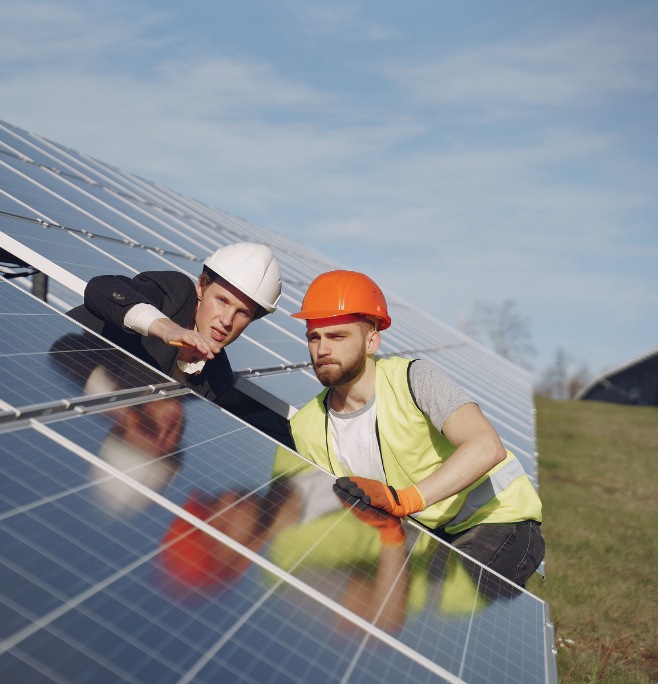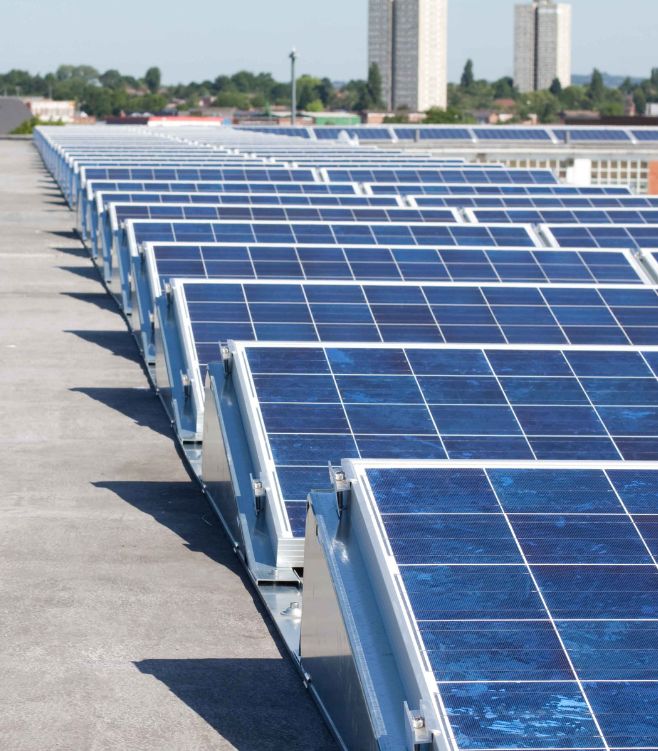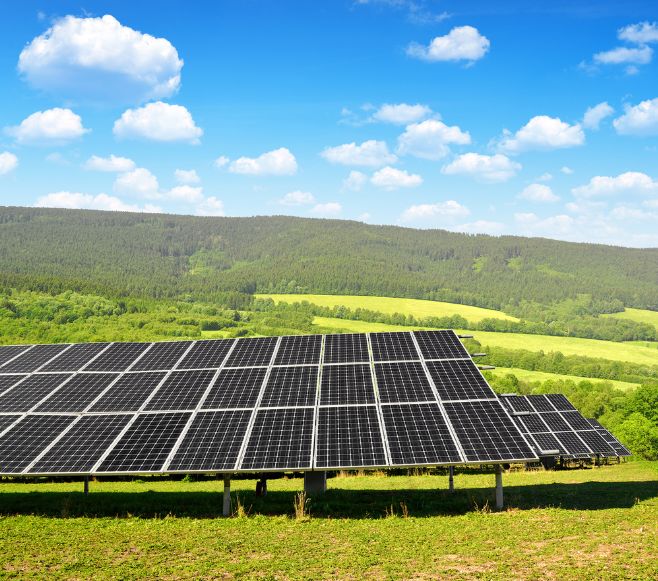Are you looking for ways to reduce your business carbon footprint by implementing a sustainable business strategy? Or are energy bills becoming a strain on your finances and you are seeking ways to reduce costs?
It's likely that both of these are true!
If so, commercial solar panel installation in Blaenavon could be an excellent option, and Skylamp Solar has the best team for the job.

It's become clear that everyone in Blaenavon must play their part in the push for renewable energy. Environmental damage has reached critical levels, global climate change is already happening, and we can no longer continue to rely on fossil fuels for our energy needs.
Solar panels will help with your aims to achieve a reduced carbon footprint and a lower dependence on energy suppliers. They'll also boost your green credentials, providing a positive company image that will attract more clients and customers to your Blaenavon business.
Also, energy costs are set to soar in the next decade, even higher than the record price rises experienced in recent times. Installing commercial solar panels will help to ease the pressure, with lower energy bills that won't stretch your company budget too far.
In fact, a 2022 study showed that installing commercial solar panels could save you between 60-70% on your energy bills.
The Skylamp Solar team are experts in commercial solar PV installation in Blaenavon, and we'll get your system up and running so you can start enjoying the benefits sooner.
Thousands of UK businesses have discovered the benefits of installing solar panels, although the majority these days opt for a solar PV system.
In the past, only one type was available; solar thermal, which produces hot water. While this system has its advantages, many business owners prefer the more versatile photovoltaic (PV) system that turns sunlight into usable electricity.
The thermal system has its uses and may be suitable for businesses that use a lot of hot water, while solar PV is ideal for bringing down those electricity bills!
Also, small businesses may be able to sell excess electricity back to the national grid, which will reduce your energy costs even further as it will offset what you are paying for electricity. With proper management and a little help from Skylamp Solar, your small business could become energy independent!


For a small or medium-sized business in Blaenavon, a commercial solar panel system would be somewhere between £16,000 and £70,000.
The huge difference here is due to the various factors that affect the overall cost, such as the system size (in kWh), how many panels are needed, whether you add battery storage, and whether you have roof-mounted or ground-mounted solar panels.
As an example, a medium-sized business with a commercial solar panel system size of 40kW would expect to pay around £42,000.
These are only rough estimates - to find out how much you need to budget for, contact Skylamp Solar to discuss your commercial solar PV system and we'll calculate a cost.

There are currently no nationwide incentive schemes or grants to encourage domestic investment in renewable energy.
However, this is very likely to change if the government is to reach its zero emissions target in 2050.
Also, there are a few regional schemes, such as the Low Carbon Workspace Grant which is available in these areas:
Businesses in these areas that invest in renewable energy, including commercial solar panels, can receive a grant of £5,000 towards the installation costs.
And if you want to invest in business solar panels in the Dorset area, the news is even better: the Low Carbon Dorset scheme offers grants to cover up to 40% of the initial installation costs of any project between £5,000 and £250,000.
However, there is another way to get commercial solar panels that won't cost you anything upfront...


A power purchase agreement (PPA) is an excellent way to finance your solar PV system without the high initial investment.
Essentially, you rent roof space for commercial solar panel installation and get all of the benefits and cost savings while not owning the system yourself.
And if you wish to buy the solar system at any stage, the PPA allows you to do this. Even better, some PPAs automatically pass ownership to the business after a set time period - usually twenty-five years. Considering that most modern solar panels have a lifespan of at least this length, this is a pretty good deal. Some of these systems will last for a good ten or fifteen years and still generate electricity efficiently.
The Skylamp Solar solar panel engineers are familiar with all the best brands and specifications, so please contact us for advice on which one would be suited to your business.
This will be calculated based on your annual electricity consumption - the average small to medium Blaenavon business uses no more than 50kWh annually.
We would also need to consider what type of business is involved; a small office block will generally use much less power than a factory or industrial building.
Related post: How many solar panels do I need?
Once we know the size of the building and the nature of the business, we would look into the following points:
Location is important here; a solar panel system based in Edinburgh would typically produce around 20% less than one based in the south of England.
We need to calculate carefully to ensure that your energy requirements are met fully. Bearing in mind that available sunlight differs according to the season, we would need to take into account the shortfall in winter. This means that you either rely on the grid for the extra energy you need in the colder months, or you select a bigger system size that overproduces in the summer.
With the latter, you could sell any excess energy back to the grid, but this involves extra investment to include battery storage in the installation. For more information about this, see the section on SEG below.
Don't worry too much if you're uncertain about the size of your solar PV system, as we will help you to calculate this and provide any information you might need.


Including solar batteries in your commercial solar panel system is optional, but it makes sense in some circumstances, depending on how much energy you need to produce.
If your working hours are mostly in daylight hours, then your solar panels will deliver most (if not all) of the energy you need to run the appliances in your building. However, if work takes place in the evening or overnight, then a battery storage system will hold the electricity generated during the day ready for you to use later.
Related post: What size solar battery do I need?
Alternatively, you can sell any excess electricity back to the grid under the SEG scheme (see below).
Solar batteries can also be set to draw electricity from your energy supplier at night when the rates are cheaper. This is handy in winter when your commercial solar installation may not generate as much power. If your panels don't deliver all the electricity that you need during the day, the batteries can act as a backup and you'll still keep costs down.
On the whole, legislation from Blaenavon Council regarding commercial solar panel installation is fairly relaxed, ever since the permitted development amendment was introduced in 2012. There are a few rules to keep in mind, and they change according to whether it's a ground-mounted array or situated on the roof space.

Installations that are smaller than nine square metres are covered by many of the same regulations that apply to domestic solar panels. In addition, you'll need to ensure that the array meets these requirements in order to avoid planning permission:
Roof-mounted installations are generally exempt from planning permission, provided they meet these conditions:
If you are considering a large-scale commercial solar panel project, known as a solar farm, you will definitely need planning permission.
Approval will only be given once the following points have been investigated and discussed:
Planning regulations can be tricky to negotiate, and local authorities may have their own clauses or conditions, so it's always best to check with them before going ahead. Please contact us if you need further advice on this matter.

The SEG scheme replaced the Feed-in Tariff* (FiT) in 2020, allowing domestic dwellings and businesses to sell excess energy from a solar array back to the national grid.
Related post: What is the smart export guarantee?
*If you are still benefiting from FiT, you won't be eligible for SEG until the contract expires.
This is really only useful to small or medium businesses, as there are limits in place as to how much electricity you can export from your commercial solar panels. These limits are set on the system size, which at present should not exceed 5 megawatts.
The main difference between FiT and SEG is that energy companies now set their own rates, ranging from 1p to 7.5p per kilowatt, so you'll need to explore this to get the best tariff.
Related post: Smart Export Guarantee Rates.
Any electricity company with more than 150,000 domestic customers is obliged to be part of the SEG scheme, while those with fewer customers can opt into the scheme if they wish to. These companies are known as SEG licensees, and it's up to you who you choose to go with. More importantly, your SEG licensee does not have to be your current energy supplier. You are free to get electricity from one company and sell any surplus from your commercial solar PV system to a completely different company.
This scheme is only open to residents and businesses in England, Scotland and Wales, so you won't be eligible if your business is based in Northern Ireland.
As mentioned above, the maximum capacity of your commercial solar panels can't exceed 5 megawatts.
You'll only be accepted by an SEG licensee if your system was installed by a certified commercial solar panel installer, usually under the Microgeneration Certification Scheme (MCS).
You'll also need an export meter or smart meter that provides updated readings every thirty minutes.
The amount varies according to the tariff you select and the actual amount of electricity your solar PV system sends to the grid.
Some SEG licensees offer a fixed rate, while others have variable rates, so this is another subject that needs careful consideration.
On average, a 5 MW solar installation might expect to gain around £250 from SEG annually at a rate of 5p per kWh.
While this might seem a disappointingly small return, it's still a way of using any excess electricity that you aren't using. Also, SEG is in its early days yet, and the government has stated its intention to monitor the scheme closely, making adjustments where necessary.
If they are to achieve the commitment to zero emissions by 2050, it's highly likely that any incentives to invest in renewable energy will be drastically enhanced.
Before purchasing commercial solar panels, you'll want to know whether they are worth the investment, and that includes getting information about efficiency.
Things can get very technical and various statistics are thrown around that can be confusing, so we'll keep things fairly simple.
In the past, solar panels could only convert between 6-15% of sunlight into usable electricity. These days, the figure is closer to 22% although there are panels that operate at 30-42% efficiency. In the very near future, we should expect to see that figure reach 50%* and maybe even beyond.
*Maximum efficiency will never be 100% in solar panels due to the second law of thermodynamics!
To give you an idea of what all this means in real terms, a US university calculated that if only 0.6% of land area in America was covered in solar PV panels of medium efficiency, they could easily provide enough energy to meet national demand.

When you check the warranty terms or product information, you might see data relating to solar panel efficiency. For example, it might suggest that the panels will be 90% efficient for the first fifteen or twenty years, falling to 80% for the remaining time.
This is confusing as it contradicts the figures given previously! However, if you come across terms like this, they are not referring to output efficiency (that is, the amount of sunlight that can be converted into usable electricity). Instead, they are referring to the actual ability of each solar module to continue electricity production.
All solar panels degrade over time; this is expected and can be measured, which is a good thing as it allows the user to gauge whether there are any problems with the system.
The level of efficiency will also depend on the type of solar panels you choose.
Here are three of the most commonly-used examples:
These are the cheapest and possibly the most popular panels as they are the simplest and use the least amount of material in manufacturing (and therefore have minimal environmental impact). However, they are also the least efficient in terms of transforming sunlight into electricity, at between 7-18%
These are made by melting many pieces of silicon together. As this is an easier process, they are less expensive than monocrystalline panels. These panels usually operate at 13-16% efficiency.
The most expensive type, with a single silicon piece that performs well, even in low levels of sunlight. This makes them easily the most efficient solar panels for business, averaging between 15-24%.
Your budget will probably dictate which type of commercial solar panels you choose, but it's advisable to go for the best ones that you can afford. If you can get a grant, this may help you to select a more expensive option.

Solar panels for Blaenavon businesses are a big investment, so you want to keep costs as low as possible, and now you discover that you need to pay extra for servicing and maintenance work.
At Skylamp Solar, we understand this completely, but without proper care and maintenance, your solar panels might not run efficiently. They might even fail completely, leaving you without an electricity supply, or at the mercy of energy suppliers charging excessive rates.
We recommend that you have your solar system inspected, cleaned and serviced at least once a year to keep it in great shape.
The good news is that they are designed to last for at least twenty-five years, and most will keep working for much longer.
Skylamp Solar provides a first-class servicing, maintenance and cleaning scheme at competitive rates, so be sure to ask about this when arranging your commercial solar panel installation.
With energy prices rising all the time, commercial solar panel installations are a worthwhile investment, even if you don't (or can't) take advantage of the SEG scheme.
From a green perspective, it's good news as well: installing solar PV panels will reduce your carbon emissions as you'll be generating your own clean energy.
Solar panels for business will start delivering benefits from the moment they are switched on!
Aside from the savings on your energy bills, the lower carbon footprint and the potential income from SEG, you will be more energy independent and present a positive brand image as a company that cares about the environment.
Business owners face many challenges and trials, and rising energy bills are just one example. Installing solar panels can provide energy security that will ease the burden, making financial forecasting a lot less hassle.
At Skylamp Solar, we strongly believe that a commercial solar PV system makes good economical sense.


As electricity costs continue to rise across Blaenavon, installing commercial solar panels is the perfect energy solution for any business that wants to save money in the long term.
The best way to maximise the return on your investment is by employing a professional commercial solar panel installer in the first place, like Skylamp Solar.
When you decide to install solar panels, we will guide you at every stage, providing advice on system size, the type of panels, battery storage, planning permission and so on. We will prepare a full quote based on your requirements and budget, and will install your solar panels quickly and efficiently.
At Skylamp Solar in Blaenavon, we are enthusiastic about solar panels for business use, as it helps SMBs (small to medium businesses) in particular to reduce their costs and become more sustainable.
This is a good thing for two reasons: it gives businesses a helping hand, and it contributes to a greener future.
Call Skylamp Solar today to give your business a brighter future.
The amount varies according to the tariff you select and the actual amount of electricity your solar PV system sends to the grid. Some SEG licensees offer a fixed rate, while others have variable rates, so this is another subject that needs careful consideration.
With energy prices rising all the time, commercial solar panel installations are a worthwhile investment, even if you don't (or can't) take advantage of the SEG scheme. From a green perspective, it's good news as well: installing solar PV panels will reduce your carbon emissions as you'll be generating your own clean energy.
On the whole, legislation regarding commercial solar panel installation is fairly relaxed, ever since the permitted development amendment was introduced in 2012. There are a few rules to keep in mind, and they change according to whether it's a ground-mounted array or situated on the roof space.
Including solar batteries in your commercial solar panel system is optional, but it makes sense in some circumstances, depending on how much energy you need to produce.